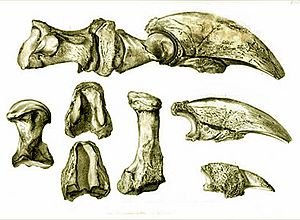Caspar Wistar (physician) facts for kids
Caspar Wistar (born September 13, 1761 – died January 22, 1818) was an American physician and anatomist. An anatomist is a scientist who studies the structure of living things. He is sometimes called Caspar Wistar the Younger to tell him apart from his grandfather, who had the same name.
Contents
Biography
Caspar Wistar was born in Philadelphia, Pennsylvania. His father was Richard Wistar and his mother was Sarah Wyatt. His grandfather, also named Caspar Wistar, was a German immigrant who was a Quaker and a glassmaker.
Education and Early Career
Caspar Wistar went to the Friends' school in Philadelphia. There, he learned about classical subjects. He became interested in medicine when he helped care for wounded soldiers after the battle of Germantown. He first studied medicine with Dr. John Redman.
He then studied at the University of Pennsylvania, earning his first medical degree in 1782. Later, he went to the University of Edinburgh in Scotland, where he received his Doctor of Medicine degree in 1786. While in Scotland, he was the president of the Royal Medical Society of Edinburgh for two years. He also led a group that studied natural history.
Medical Contributions
When he returned to the U.S. in 1787, Caspar Wistar started practicing medicine in Philadelphia. He quickly became a doctor at the Philadelphia Dispensary. From 1789 to 1792, he taught chemistry at the College of Philadelphia. When that school joined with the University of Pennsylvania, he became a professor of anatomy, childbirth, and surgery. In 1808, he became the head professor of anatomy and stayed in that role until he died. In 1803, he was chosen as a member of the American Academy of Arts and Sciences.
To help his students learn, Wistar created special models of human body parts. These models were made by injecting wax into preserved human remains. He also wrote an important book called A System of Anatomy, published in two parts between 1811 and 1814. Many students came to his lectures, which helped make the University of Pennsylvania's medical school famous.
He also worked as a doctor at the Pennsylvania Hospital until 1810. Wistar was known for his detailed description of a part of the ethmoid bone, which is a bone in the skull. His work on this bone was recognized around the world.
Caspar Wistar was also one of the first people to support vaccination to prevent diseases. During the yellow fever epidemic in 1793, he got sick with the disease himself while taking care of his patients.
Wistar Parties and Other Roles
Wistar had a special tradition: he would open his home once a week during the winter. These gatherings were called "Wistar parties." Students, scientists, and travelers would meet to talk about interesting topics. These famous parties continued in Philadelphia even after his death.
In 1787, he became a member of the American College of Physicians. He also joined the American Philosophical Society in 1787. He served as its vice-president and later became its president in 1815, after Thomas Jefferson stepped down. He was also the president of the Society for the Abolition of Slavery, following Benjamin Rush. This society worked to end slavery.
The plant expert Thomas Nuttall named the beautiful flowering plant Wisteria in honor of Caspar Wistar. Also, the Wistar Institute of Anatomy and Biology at the University of Pennsylvania, founded in 1892, is named after him.
Wistar was a good friend of Thomas Jefferson. They worked together to identify bones of the megalonyx, a giant prehistoric ground sloth. Wistar also helped teach Meriwether Lewis before the famous Lewis and Clark expedition, giving him advice for scientific research.
Family
Caspar Wistar married Isabella Marshall in 1788, but she passed away in 1790. He then married Elizabeth Mifflin in 1798.
His brother, Richard Wistar, was a merchant in Philadelphia. He owned a large store where he sold iron and hardware. Richard used his profits to buy land and houses. During the Revolutionary War, Richard believed in defending property with weapons. Because of this, he was no longer part of the Society of Friends, as Quakers are against violence. Richard also worked as an inspector of prisons and supported the Library Company of Philadelphia and the Pennsylvania Hospital.
Caspar Wistar was also a cousin of Sally Wister, who wrote a famous diary during the Revolutionary War.
Death
Caspar Wistar died on January 22, 1818, from a serious illness called "typhus fever."
See also
- Organ Cave
- List of eponyms



